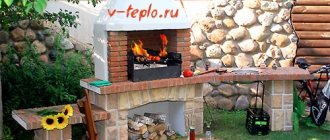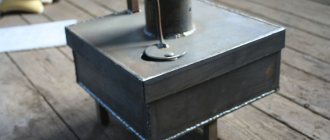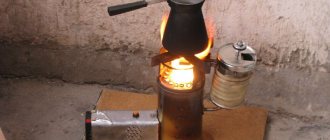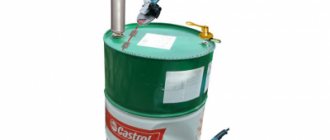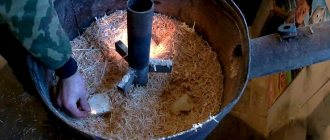What if there is nowhere to throw the trash out? Take, for example, a summer cottage or a house in a village. There are no waste bins within a radius of several or even tens of kilometers. How to be? Leave it in place or throw it in a ditch on the way home? Observing a similar picture in the suburbs, we are indignant in our souls.
There is a way out: some of the waste can be burned. But it is dangerous to do this on an open fire. It is better to use a dedicated garbage oven. Various models of Russian and foreign production are sold on the market. It is easy to make a stove, having the materials at hand and skill.
Installation and operation of a waste incinerator
The waste incinerator is installed according to the rules or its own calculated drawings. If the item is from a store, it is better to entrust the installation and adjustment to the service department.
Additional permission for the installation of a household structure at a summer cottage is not required, but no one cancels the instructions and operating rules.
Working with a flame requires caution, because the safety of life, home and the prevention of harm to the environment is more important than the benefits that household incinerators provide.
General advantages and disadvantages
Let's take a look at the advantages and disadvantages of self-incineration in the country.
| Benefits | disadvantages |
| Disposal of solid waste where collection is not organized. | Not all household waste is safe and incinerable. |
| Recycling in an environmentally friendly way. | Strict adherence to fire safety requirements and standards is sometimes difficult. |
| The resulting ash is useful for fertilizing the backyard. | The price for purchased installations starts from fifteen thousand. |
| Receiving additional heat sources for heating water, heating, cooking. | Impossibility of incineration of liquid waste. |
| Extending the life of old things: pipes, barrels, fuel boilers, etc. | The damage caused by the incinerated waste to the atmosphere will have to be reduced by filtering the smoke. |
| Profitability in handicraft production. | Low efficiency. |
The plasma waste incinerator is fast and environmentally friendly. At the same time, at the output, electricity is obtained in an amount sufficient to supply power to enterprises, recycled products - slags, which are used, for example, in construction.
We advise you to read: What is pyrolysis and products obtained at the exit from pyrolysis plants
Unlike standard incinerators, plasma processing does not emit carbon dioxide or toxic substances into the atmosphere.
Advantages and disadvantages of a long burning oven
A pyrolysis oven as a heating device has a number of advantages:
- Environmental Safety. Virtually complete combustion of food without producing toxic fumes.
- Profitability. Longer burning times require less fuel.
- The ability to connect to a heating device with any type of circuit.
- Recycling. Instead of fuel, garbage is loaded into the unit.
- The efficiency is 85%. With low fuel consumption, the room is heated in a short period of time.
- Availability. The stove can be installed independently without the help of masters.

The main disadvantage of pyrolysis plants is their dependence on the AC network. Powerful units cannot provide themselves with sufficient traction, therefore fans are additionally built into them.
Today pyrolysis is the most efficient way of waste disposal. As a result of this process, no hazardous and harmful substances remain. Even the storage of pyrolysis waste does not harm the environment.
Safety regulations
When working with an incinerator, adhere to safety rules, as this is a fire hazardous facility. It should not be located near flammable objects. Do not store flammable materials, dry grass, wood or planks, trees nearby. An accidental spark has dire consequences.
The waste incineration boiler is not placed closer than 50 meters from residential, utility, and other buildings. The proximity of power lines, gas pipelines, other networks and communications is taken into account. For violation of this requirement, there is even an administrative fine of thousands of rubles.
Children, animals must not be allowed near the burning fire, and they must not be left unattended. Place extinguishing media in the immediate vicinity: water, sand, fire extinguisher.
DIY ovens
The most versatile and widely used oven mine type
with a sufficiently high efficiency (up to 75%) is "R 'SOR" RµS "SSCR". There are 6-8 pipes on the sides of such a boiler. Their lower ends "suck" cold air from below. The pipes that tightly surround the stove quickly absorb the heat and throw it up into the room. On our site there is a very detailed description of the Buleryan principle of operation.
Stove "Buleryan"
The economical РїРµС ‡ СЊ РЅР ° отрР° Р ± отке proved itself quite well. Its design is as simple as possible, and making such a boiler yourself does not present any particular problems.
Working furnace
A very original (and, most importantly), quite effective design top-fired
and high efficiency is the "R 'S‘R ± PSC" R ° PЅSЏ "furnace. It was based on the widely advertised model "Stropuv". But, unlike the industrial model, the Bubofani design is extremely simple, and any novice welder can do it. You can get acquainted with the principle of its work and the stages of its creation by following this link.
Bubofanya oven
svoimi-rukamy.net
What can't be burned?
Only organic waste is subject to incineration. This is garden waste - branches, grass, leaves, etc. It is allowed to burn paper, cardboard, and unusable wooden objects.
When burning, materials made of plastic, polymers, synthetics emit toxic substances that are harmful to human health and the ecology of the environment.
Cannot be burned:
- Painted parts.
- Full-color glossy printing with ink content.
- Chipboards, fiber boards, which used glue and phenols.
Not every oven is suitable for burning paper. It is dangerous to throw aerosol cans, glass, metal objects into fire. Even empty, but under pressure, can explode in fire.
How such ovens are arranged
Despite the fact that such designs work with high efficiency, their design is not very complicated. Having certain skills in performing construction work, any home craftsman will be able to make a pyrolysis stove on his own.
It is based on a body into which a firebox is built for laying firewood. In order to limit the flow of oxygen into the pyrolysis furnaces, it is necessary that the firebox be made hermetically, the door must close tightly in it, and the valve must work reliably.
After the firewood is laid in the pyrolysis ovens, their arson can be done manually or with the help of a burner, in the same way as an ordinary potbelly stove is set on fire. It is necessary to give some time for the firewood to burn well. Then oxygen limitation is performed.
When burning wood, a lot of gas is released, after which it is directed through special channels to the second combustion chamber. Here, the produced gas is mixed with secondary air and burned at very high temperatures, with the release of a large amount of heat.
Depending on the design of the pyrolysis stove, the second chamber is sometimes combined with an air duct or chimney inlet. If the chimney system is well thought out, then in the presence of sealed dampers, the second chamber of the pyrolysis stove can also work with natural draft with upper air intake, while it is not necessary to use a supply and exhaust fan. In some designs, the second chamber can be provided with a main fan, and in some, an additional one is installed for this.
If you need residues from the combustion of firewood, then at a certain stage they can be removed from the pyrolysis stove, for this, both in handicraft and industrial stoves, a rotary retort is provided. It is made in the form of a round part of the body, into which firewood is laid, and after their combustion, coke or coal is extracted from below.
If a potbelly stove provides fuel combustion in one stage, then pyrolysis stoves carry out this in two stages: first, solid residues are burned, and then gas. During gas combustion, combustion is maintained in the primary chamber, which allows fuel to be burned almost without residue. This greatly facilitates the maintenance of the pyrolysis stove, since the ash must be cleaned every 5-7 days.
Ready-made incinerators
Waste incinerators in their simplest design are similar to an ordinary metal barrel. The upgraded structures are equipped with a chimney, a blower, a tank for fuel intake, filters and other useful functions. Up to water heating or heating. Many parameters of a purchased oven depend on the capabilities of the owner's wallet.
A garbage incinerator is an incinerator with a chimney. The larger the combustion chamber, the faster disposal will take place, and a reliable chimney will save the owners and neighbors from unpleasant annoying smoke.
Furnace manufacturing options
The design of the oven can be complicated by turning it into a convector. To do this, it is equipped with vertical pipes with a diameter of 60 to 100 mm, 2/3 of the diameter of which must be inside the firebox. To increase the contact area of the pipes with the high-temperature zone of the furnace, they are made curved.
Note! The diameter of the pipes is selected taking into account the viscosity, heat capacity and thermal conductivity of air. The use of thinner air ducts, even with an increased number of them, will lead to a deterioration in the characteristics of the convector.
Outside, the heat generator can be sheathed with a protective cover. Then its temperature during the operation of the furnace in the gas generation mode will not exceed 50–55 degrees. The air coming out of the pipes will have a temperature of 60-70 degrees.
A homemade pyrolysis oven can be equipped with a catalyst, also made by yourself. Nichrome is a good material for him. You can also make a ceramic catalyst based on a brick or a baked clay tube. An oxide of a transition metal, for example, manganese, or an element from the platinoid group, is applied to it as follows:
- The metal salt (it should not be resistant to high temperatures) is dissolved in water, after which the ceramic base is impregnated with this solution.
- Further, the future catalyst is dried at a temperature of 160-200 degrees.
- Now the part needs to be calcined in the open air, heated to a temperature of 600-800 degrees.
The most readily available platinum salt is ammonium hexachloroplatinate, manganese nitrate can be used to make a manganese catalyst, and vanadium can be easily obtained from ammonium vanadate.
Waste incinerator - a complex for the destruction of solid waste
An incinerator, or incinerator, helps to quickly, easily get rid of household waste. Such ovens are in demand among summer residents and villagers.
It is more difficult in the design and operation of an installation for the incineration of hazardous and hazardous waste: medical preparations and used equipment, animal corpses, chemical products.
We advise you to read: Environmental pollution by oil and oil products
The difference between pyrolysis furnaces for burning garbage is that the combustion takes a long time. The principle is based on reducing the oxygen content required to maintain a flame. Therefore, the fuel does not burn, but smolders slowly, releasing pyrolysis gas. Hence their second name is a smokeless waste incinerator.
In the second cycle of operation of such a smokeless furnace, oxygen is already added to completely burn out the fuel.
Which oven to choose?
Today you can find drawings and diagrams of a long-burning furnace of the most diverse design, size and performance. However, how effective will the selected homemade equipment be, and where can it be used? Experts answer this question as follows: for non-residential premises, a homemade pyrolysis oven from scrap materials is perfect. However, it will be weak and short-lived.
For living spaces, not only aesthetics are important, but also performance. In this case, you need to pay attention to the stove in a modern modification. Its modified air duct and water shirt will heat the room up to 25 square meters. In order to increase the efficiency and heat a larger house, the size of the long burning stove must not be increased. To solve this problem, they opt for brick pyrolysis units. Thematic video on how to make a potbelly stove with your own hands:
A pyrolysis oven definitely requires a lot of knowledge if you have an idea for a pyrolysis oven with your own hands. And the first number of the list of knowledge will appear - understanding of the pyrolysis process. The use of solid fuel gas-generating boilers in private households has become popular. However, buyers are only offered calculations of the efficiency and merit of the installations. You should be aware that thermal decomposition of wood occurs in almost all cases of its combustion.
Homemade constructions
The zealous owners make a garden oven for burning garbage with their own hands in their personal plots. A metal barrel or a large diameter piece of iron pipe will do.
For the base according to the size of the bottom of the future furnace, a recess is dug in the ground, approximately on the bayonet of a shovel. Along the perimeter, they are lined with bricks, a firebox is installed on them. Holes are drilled at the bottom for blowing. It is good if the homemade stove is equipped with a door for adding fuel and collecting the remaining ash.
A lid with a built-in chimney will come in handy. Features, appearance, practicality of such a homemade design depend on the skills of the master, materials and tools.
Metal barrel
It is easier to make a garden waste stove from a two-hundred-liter metal barrel. The thicker its walls, the longer it will serve. For the same reason, it is important that it does not rust.
Old heater
An old sauna stove will serve as a garbage stove in the country. If you love giving things a second life, rather than throwing them away, this option is fine.
The essence of pyrolysis ovens
It is possible to read the drawing of a long-burning furnace correctly and, on its basis, to make high-quality heating equipment, if you understand the whole essence of the processes that take place during the pyrolysis of fuel decomposition. It vaguely resembles the cracking of oil, but is performed with solid fuels in a slightly different temperature range.
Solid fuel pyrolysis takes place at a temperature of 450 ° C and under conditions of oxygen deficiency. The result is a gas consisting of wood fractions. Its ignition temperature is significantly higher compared to the energy that is released when burning solid fuels. This determines the high efficiency of heating equipment (80-85%).
Energy carrier transformation stages.
The principle of operation of a long-burning furnace is based on the following stages of solid fuel pyrolysis:
- drying the energy carrier;
- directly pyrolysis;
- combustion of light, volatile fraction and parallel carbonization of fuel;
- decomposition of heavy fractions to a volatile state;
- reduction reaction at a temperature of + 400 ° C.
As a result of the last reaction, pure hydrogen, carbon monoxide, is obtained. It is as a result of their oxidation that a large amount of heat is released. However, the device of a long-burning furnace must be organized in such a way that the temperature in it does not drop below + 250 ° C. Otherwise, carbon monoxide and hydrogen will not oxidize, but will go outside without giving up their part of the heat.



